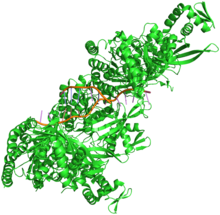| recA bacterial DNA recombination protein | |||||||||
|---|---|---|---|---|---|---|---|---|---|
 | |||||||||
| Identifiers | |||||||||
| Symbol | RecA | ||||||||
| Pfam | PF00154 | ||||||||
| Pfam clan | CL0023 | ||||||||
| InterPro | IPR013765 | ||||||||
| PROSITE | PDOC00131 | ||||||||
| SCOP2 | 2reb / SCOPe / SUPFAM | ||||||||
| |||||||||
RecA is a 38 kilodalton protein essential for the repair and maintenance of DNA in bacteria.[2] Structural and functional homologs to RecA have been found in all kingdoms of life.[3][4] RecA serves as an archetype for this class of homologous DNA repair proteins. The homologous protein is called RAD51 in eukaryotes and RadA in archaea.[5][6]
RecA has multiple activities, all related to DNA repair. In the bacterial SOS response, it has a co-protease[7] function in the autocatalytic cleavage of the LexA repressor and the λ repressor.[8]
- ^ Chen, Z.; Yang, H.; Pavletich, N. P. (2008). "Mechanism of homologous recombination from the RecA–ssDNA/dsDNA structures". Nature. 453 (7194): 489–4. Bibcode:2008Natur.453..489C. doi:10.1038/nature06971. PMID 18497818. S2CID 4416531.
- ^ Horii, T; Ogawa, T; Ogawa, H (January 1980). "Organization of the recA gene of Escherichia coli". Proceedings of the National Academy of Sciences. 77 (1): 313–317. Bibcode:1980PNAS...77..313H. doi:10.1073/pnas.77.1.313. PMC 348260. PMID 6244554.
- ^ Lin, Zhenguo; Kong, Hongzhi; Nei, Masatoshi; Ma, Hong (5 July 2006). "Origins and evolution of the recA / RAD51 gene family: Evidence for ancient gene duplication and endosymbiotic gene transfer". Proceedings of the National Academy of Sciences. 103 (27): 10328–10333. doi:10.1073/pnas.0604232103. PMC 1502457.
- ^ Brendel, Volker; Brocchieri, Luciano; Sandler, Steven J.; Clark, Alvin J.; Karlin, Samuel (May 1997). "Evolutionary Comparisons of RecA-Like Proteins Across All Major Kingdoms of Living Organisms". Journal of Molecular Evolution. 44 (5): 528–541. doi:10.1007/pl00006177.
- ^ Shinohara, Akira; Ogawa, Hideyuki; Ogawa, Tomoko (1992). "Rad51 protein involved in repair and recombination in S. cerevisiae is a RecA-like protein". Cell. 69 (3): 457–470. doi:10.1016/0092-8674(92)90447-k. PMID 1581961. S2CID 35937283.
- ^ Seitz, Erica M.; Brockman, Joel P.; Sandler, Steven J.; Clark, A. John; Kowalczykowski, Stephen C. (1998-05-01). "RadA protein is an archaeal RecA protein homolog that catalyzes DNA strand exchange". Genes & Development. 12 (9): 1248–1253. doi:10.1101/gad.12.9.1248. ISSN 0890-9369. PMC 316774. PMID 9573041.
- ^ Horii, Toshihiro; Ogawa, Tomoko; Nakatani, Tomoyuki; Hase, Toshiharu; Matsubara, Hiroshi; Ogawa, Hideyuki (December 1981). "Regulation of SOS functions: Purification of E. coli LexA protein and determination of its specific site cleaved by the RecA protein". Cell. 27 (3): 515–522. doi:10.1016/0092-8674(81)90393-7. PMID 6101204. S2CID 45482725.
- ^ Little, JW (March 1984). "Autodigestion of lexA and phage lambda repressors". Proceedings of the National Academy of Sciences. 81 (5): 1375–1379. Bibcode:1984PNAS...81.1375L. doi:10.1073/pnas.81.5.1375. PMC 344836. PMID 6231641.